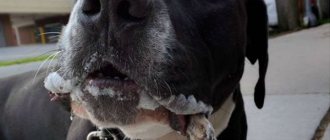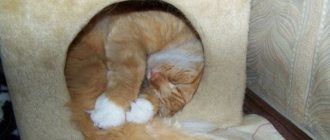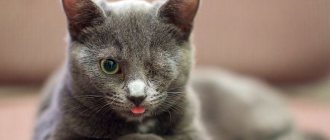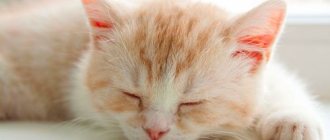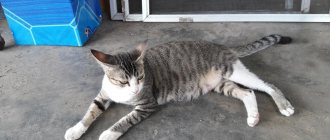Arthropod parasites
Spot-on drops against fleas.
helminths and mites Crusts are formed as a result of the activity of subcutaneous mites Otodectes and Notoedrus. Arthropod parasites constantly live in the cat’s body, but do not cause any significant harm to it as long as the immune system restrains their reproduction.
Otodectes parasitize from the inner surface of the auricle. They dig holes under the skin and lay eggs. The damaged surface itches, an ichor forms, and when it dries, crusts form.
If the inner surface of the sink is dry, soften the crusts and apply Amidel-gel, Amitrazine, Amit, Ivermek-gel or similar acaricidal agents. Most often, treatment consists of two applications at a five-day interval.
In advanced cases, otitis media develops. A mass similar in consistency to coffee grounds spills out of the ear canal. In such cases, ear drops Surolan, Aurikan, Otibiovin are used for treatment.
Unlike Otodectes, Notoedrus mites parasitize on the outside of the shell. Arthropods love to travel. They rise through tunnels to the surface of the skin, and upon contact they can move on to other individuals, including people who stroked the kitty. Mites can live for several weeks on uncomfortable human skin and cause redness and itching.
However, the parasite does not reach sexual maturity and the pathological condition ends with a quick recovery without any treatment.
With Notoedrosis, in addition to the ears, the muzzle is affected
Notoedrus first causes baldness and crusting on the outer surface of the shell. Then they spread to the face and torso. Cats sleep curled up in a ball, so traveling parasites quickly spread throughout the body. Treatment is carried out with the same drugs as for otodectosis.
Be sure to read:
A cat has an earache: causes, how to understand, symptoms, first aid, what to do at home
However, instead of two treatments, five may be required. Prevention consists of adequate feeding, as well as regular use of Spot-on drops against fleas, helminths and subcutaneous ticks.
Bald spots on the paws and stomach: photos, causes, advice from veterinarians
A lot has been written here about feeding cats. He has already accumulated it both from old age and from improper feeding. I would remove boiled crucian carp and sausage from the table and choose medicinal professional premium food, or only in nature (but you have to weigh everything with a scale and cook it once a week). Our friends have a 14-year-old cat - the hair was peeling off from the ears and legs, itching until it bled - they fed it haphazardly, after they switched it to normal food, the cat came into divine shape. Here. My point is that animal nutrition is of primary importance for health. Everything is the same as with people.
Yanchik, put the cat on a diet, this is advisable. Try to replace the fish with boiled chicken, or lean beef. Fish, especially river fish, is not suitable for feeding cats, especially at this age. Try to remove sausages altogether, there are a lot of substances that are harmful to people, not just cats. Curdled milk, egg, low-fat cottage cheese, chicken, beef, chicken heart and gizzards, all boiled, but what am I telling you, read our threads about feeding natural and industrial feeds, choose what suits you. It is necessary to have blood analyzed and scraped for culture; without this, who will figure out what to treat the cat for. Consider age, this is also important, because an animal at that age needs, just like a person, a certain diet and care.
Thank you very much for the advice) we will definitely listen: smile:
Allergy
Atopic dermatitis
Allergy is a hypersensitive response to an irritant.
Crusts on the ears occur with the following types of allergies:
- Flea dermatitis: the body becomes sensitized to the saliva of the arthropod and with repeated bites a violent reaction develops. In addition to the ears, the inflammatory process with the formation of crusts spreads to the neck, muzzle, and torso.
- Atopic dermatitis is a reaction to external irritants: pollen, smoke, perfume. Dry eczema develops. The pathology is congenital and occurs in predisposed individuals.
- Contact dermatitis - occurs with the same symptoms as atopic dermatitis, but is not congenital and can be treated.
- Food allergy: develops in cats predisposed to an inadequate reaction to any food ingredient. It occurs with signs of dry eczema.
- Reaction to medications: occurs due to individual intolerance. Characterized by skin rashes or swelling.
- Photosensitization - the mechanism of its occurrence has not been sufficiently studied. Endotoxins accumulate in the skin, which, when exposed to sunlight, cause burns reminiscent of those that a person gets on the beach. Short-haired individuals of white color suffer.
Sunburn due to photosensitivity
Allergic manifestations are treated by eliminating the causes.
Depending on the type of allergy, the following remedies are used:
- insecticides;
- anti-inflammatory corticosteroids;
- antihistamines;
- hypoallergenic ready-made food;
- wound healing ointments.
The cat's skin is peeling
27.03.2018
Currently, 7 breeds of hairless (or almost hairless) cats have been developed and are quite common in the world. These are the Devon Rex, the Canadian Sphynx, the Don Sphynx, the Ukrainian Levkoy, the Peterbald (St. Petersburg Sphynx), the Bambino and the Lycoi (very rare wool). Each of these breeds is individual in its own way; they differ in constitution, shape of eyes, ears, head, and character. These cats attract a lot of attention; some cannot take their eyes off them in delight, while others are frightened by their unnatural appearance. One thing is for sure, there are no indifferent people. The lack of hair is their calling card, but it also causes cats a lot of trouble. Hairless cats are afraid of the cold and direct rays of the sun; they have more sensitive skin to insect bites and allergens. Just like other animals (and humans), the skin of cats is a kind of indicator of health. Therefore, if the Sphynx’s skin is peeling or any rashes appear, then you should take a closer look at your pet.
Fungal dermatitis
Fold cats are predisposed to Malassezia otitis.
The yeast fungus Malassezia is a permanent inhabitant of the cat's skin. In individuals with immunity weakened by the underlying disease, when kept in conditions of heat and high humidity, yeast begins to multiply.
The ear canal is affected. The cat scratches the itchy area, the ichor comes out, dries out, and crusts form. Fold-eared cats are predisposed, as are pets with large ears. Treatment is prescribed by a veterinarian. These are drugs that eliminate the underlying disease, external or systemic antimycotics.
Be sure to read:
The cat has a stomach ache: causes, symptoms, what to do, whether it needs to be treated, what not to do
Prevention involves regular ear cleaning.
Cat's skin is peeling: where to look for the cause?
Pet club forums > Talk about animals > Cats, cats, kittens... > The cat has scabs on his ears
View full version: The cat has scabs on his ears
Hello, please help! About a month ago we noticed that the cat would not let anyone touch his right ear. At first they attributed this behavior to its natural harmfulness, but later they discovered a small scab. They immediately took him to the vet. There they cleaned his ear, gave him an injection and prescribed Otoferonol drops and some kind of tar-based ointment. They smeared and dripped for 10 days, but there was no change. The cat was still shaking. We decided to take him to another veterinary clinic. There they took various tests from him and made a preliminary diagnosis of diabetes mellitus. And when the blood tests were ready, they generally said it was a fungus. They prescribed expensive medications (ointments, drops). They smeared and dripped for 10 days. The cat has stopped grumbling, but the scabs are appearing again and have already spread to the head and even a little to the nose. The cat hardly touches his ears. Tell me how to deal with this? The cat is 14 years old
Poor him! What about the diet? What do you feed? The ticks were probably cured, but diabetes probably remained. You don’t just make such a diagnosis, unless of course you have faith in your doctor. Maybe I need to feed it differently? The age is also old.
What specific fungus?
We feed boiled fish (crucian carp), dry food, and often buy canned food for cats. Mom loves to spoil him with food from our table (sausage, cheese, etc.). And we don’t know whether to believe the doctors or not...
And they didn’t even tell us about the type of fungus...
And they didn’t even tell us about the type of fungus... That’s interesting... :unsure: Fungus is a broad concept. It rarely happens on its own; usually there is an additional infection: cocci, E. coli, etc. disgusting. You still need to redo the scrapings (microscopic examination and culture) in a normal laboratory, then it will be clear what to treat. Without this, you can only do harm with advice. :and don't think:
Causes and symptoms of this condition
The reasons why a cat's skin peels can be divided into internal and external factors.
External causes cause irritation of the skin upon direct contact with them. These factors include:
- Physical. Sudden changes in temperature, excess sun, lack of humidity and poor ventilation of the room often lead to active peeling of the skin or hair loss.
- Chemical. Poor-quality collars, litter, shampoos and other cosmetic products for cat skin care can lead not only to excessive peeling of the skin, but also cause the development of dermatitis or eczema.
- Infectious. All fungal infections are accompanied by hair loss in the initial stages, and when the condition worsens, they lead to peeling of the skin. One of the most common diseases of this type is lichen; these symptoms are also characteristic of diseases such as dermatitis and demodicosis. The presence of any parasites almost always leads to the appearance of an excessive amount of dandruff, since the sebaceous glands of the cat or cat malfunction.
- Mechanical. Peeling may occur at the site of a recent injection or in the presence of abrasions or scratches.
In most cases, it is enough to remove the root cause to rid your pet of flaking.
Internal causes are directly related to unbalanced nutrition, complications from stress and diseases of the digestive tract. Let's take a closer look at each of these factors:
- Problems in the digestive system. Most often, a cat's skin peels off on the back and other parts of the body during the secondary stage of the disease. First of all, problems with stool, sudden weight loss, apathy and refusal to eat are observed. Such signs may signal the development of a tumor in the digestive organs.
- Incorrectly selected diet. Excessive presence of carbohydrates in the daily diet, lack of essential vitamins and minerals, leads to vitamin deficiency and the development of allergies, which causes flaking and contributes to baldness.
- Psychological disorders. The pet suffers from mood swings, in addition to hair loss and flaking, severe itching and ulcers may occur.
Often the cause of the described problem lies in various endocrine diseases, hereditary pathologies and sebaceous adenitis, which, in addition to the indicated symptoms, is characterized by the destruction of the sebaceous glands.
Effective Treatments
Therapy is selected based on the diagnostic results and the identified cause of the pathology:
- Allergy. Changing your pet's diet, changing food.
- Mite. It is recommended to bury the ears with Tsipam or Stronghold drops. It is important to regularly carry out hygiene procedures, cleansing the affected skin of dark plaque.
- Lichen. Requires immediate treatment. Sulfur ointment or “Yam” remedy is prescribed. It is important to be careful until your pet recovers so that the disease does not spread to people.
- Hematoma, neoplasm. Surgical intervention is performed with further local treatment of the wound.
How to prevent the development of the disease
Ear diseases are common among cats. There are a number of simple rules to avoid the development of pathology:
- Regular examination of your pet's ears and careful cleaning.
- Avoiding hypothermia, frostbite, and getting your ears wet.
- Proper nutrition.
- Timely vaccination. This is especially important if your pet goes outside.
- Limit contact with other animals if the cat is indoor and does not go outside.
Timely vaccination is a way to prevent the development of diseases.
A purring fluffy is not a toy, but a living creature, and every cat owner is responsible for his pet. If any changes in the animal's behavior occur, it should be examined and consulted with a doctor.
Recommended Posts
How to cure demodicosis in a dog and save your pet’s life
Basic symptoms and rules for treating cystitis in cats
Causes and methods of treating acne in cats
The first symptoms and features of treatment of piroplasmosis in dogs
Possible causes, methods of diagnosis and treatment of black feces in cats
Symptoms and popular treatments for staphylococcus in dogs
Diagnostic methods
To choose the right treatment, you need to accurately determine the diagnosis. The following methods are used for this:
- general examination;
- scraping;
- microbiological study of hair roots during the formation of bald patches;
- general and biochemical blood test;
- Ultrasound, x-ray if the formation of a neoplasm is suspected.
If your cat is in pain, it will be difficult to examine him. It is important to follow all safety precautions during examination in case the disease could be dangerous to humans.
Signs of the described deviations
Peeling of the skin is accompanied by the appearance of dandruff throughout the animal's body. Most often, the main areas of damage are the back and the area near the tail. The main signs of peeling skin and hair loss include:
- Excessive thinning or thickening of the animal’s skin;
- Necrosis of a large area of the stratum corneum of the skin caused by pathologies of an internal or external nature;
Almost always, flaking and baldness are accompanied by itching, the presence of which affects the condition of the pet’s skin - it worsens significantly. In addition, the entry of bacteria into scratched wounds leads to the development of inflammatory processes on the skin.


